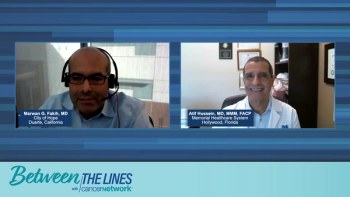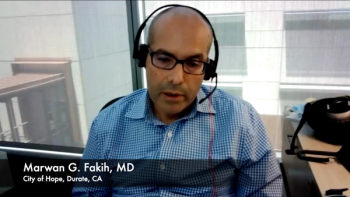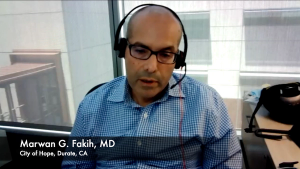
Hear from leading cancer experts about the lasting impact the COVID-19 pandemic has left on clinical practice.

Your AI-Trained Oncology Knowledge Connection!


Hear from leading cancer experts about the lasting impact the COVID-19 pandemic has left on clinical practice.

The approval of sotorasib plus panitumumab is a “welcome step” in KRAS G12C-mutated colorectal cancer, according to Marwan G. Fakih, MD.

Combining sotorasib with panitumumab may reduce the burden of disease in patients with KRAS G12C-mutated metastatic colorectal cancer.

Findings from the CodeBreak 300 study have cemented sotorasib/panitumumab as a third-line treatment option for KRAS G12C-mutated colorectal cancer.

Sotorasib plus panitumumab may offer improved survival compared with previously approved treatment options in KRAS G12C-mutated colorectal cancer.

Marwan G. Fakih, MD, and Atif Hussein, MD, MMM, FACP, conclude their discussion with advice for clinicians treating patients with metastatic colorectal cancer.

Colorectal cancer specialists discuss the effect of the SUNLIGHT trial data on the overall treatment and research landscapes.

Experts on colorectal cancer provide their key takeaways from the results from the SUNLIGHT study.

A comprehensive review of outcome data from the SUNLIGHT clinical trial in patients with refractory metastatic colorectal cancer.

Marwan G. Fakih, MD, reviews the study design for the SUNLIGHT clinical trial investigating trifluridine-tipiracil plus bevacizumab in patients with refractory metastatic CRC.

A brief overview of treatment options available for patients with colorectal cancer prior to the SUNLIGHT study.

Comprehensive insights on the stratification, diagnosis, and treatment of patients with metastatic colorectal cancer.

Marwan G. Fakih, MD, and Atif Hussein, MD, MMM, FACP, introduce themselves and give an overview of metastatic colorectal cancer (mCRC).

CancerNetwork® sat down with Marwan G. Fakih, MD, of City of Hope at the 2021 ASCO Annual Meeting to talk about a potential multidisciplinary treatment approach to colorectal cancer with regorafenib/nivolumab.

The treatment of anal squamous cell cancer with definitive chemoradiation is the gold-standard therapy for localized anal cancer, primarily because of its sphincter-saving and colostomy-sparing potential.

Although anal cancer is a rare disease, its incidence is increasing in men and women worldwide. The most important risk factors are behaviors that predispose individuals to human papillomavirus (HPV) infection or immunosuppression. Anal cancer is generally preceded by high-grade anal intraepithelial neoplasia (HGAIN), which is most prevalent in human immunodeficiency virus (HIV)-positive men who have sex with men. There is a general consensus that high-risk individuals may benefit from screening. Meta-analysis suggests that 80% of anal cancers could be avoided by vaccination against HPV 16/18. Nearly half of all patients with anal cancer present with rectal bleeding. Pain or sensation of a rectal mass is experienced in 30% of patients, whereas 20% have no tumor-specific symptoms. According to the Surveillance Epidemiology and End Results (SEER) database, 50% of patients with anal cancer have disease localized to the anus, 29% have regional lymph node involvement or direct spread beyond the primary, and 12% have metastatic disease, while 9% have an unknown stage. Clinical staging of anal carcinoma requires a digital rectal exam and a computed tomography scan of the chest, abdomen, and pelvis. Suspicious inguinal lymph nodes should be subject to pathologic confirmation by fine-needle aspiration. The 5-year relative survival rates are 80.1% for localized anal cancer, 60.7% for regional disease, and 29.4% for metastatic disease. Part 2 of this two-part review will address the treatment of anal cancer, highlighting studies of chemoradiation.

Minsky and Guillem should be commended for this excellent review and for addressing major areas of controversy in the management of rectal cancer.

Neoadjuvant chemoradiation has become the favored adjuvant treatment for stages II and III rectal cancer. Compared to postoperative chemoradiation, this modality of treatment has been shown to be superior in terms of toxicity, local relapse, and sphincter-saving.[1] This article will focus on the evolution of neoadjuvant chemotherapy over the past 2 decades, current acceptable neoadjuvant standards, and current investigational regimens.

Targeting the epidermal growth factor receptor (EGFR) has proven to be of clinical benefit in the management of metastatic colorectal cancer (mCRC). While the use of small-molecule tyrosine kinase inhibitors in this setting has not shown any significant activity and has been associated with increased gastrointestinal toxicity when combined with chemotherapy, a different picture has emerged with the use of EGFR-targeting monoclonal antibodies.

Colorectal cancer is the second most common cause of cancer death in the United States. It is estimated that about 55,000 patients will die this year due to advanced colorectal cancer. These grim statistics persist despite a marked increase in the rate of screening colonoscopies and improvements in adjuvant chemotherapy. Successful chemoprevention strategies may reduce the risk of new colorectal cancers, thus decreasing related overall morbidity and mortality.

Carcinoembryonic antigen (CEA) monitoring in patients with stage I-IV colorectal cancer has been, and remains, a controversial issue in oncology practice. Recommendations vary from bimonthly monitoring to no monitoring in the surveillance setting (for stage I-III disease). In the metastatic setting, there are no clear guidelines for CEA follow-up, although continued monitoring in such patients is common in the oncology community. This manuscript reviews the accuracy of CEA testing, its value as a prognostic indicator, and its role in surveillance and response assessment. The limitations of the test in the adjuvant and metastatic settings are illustrated through several case reports from the Colorectal Oncology Clinic at Roswell Park Cancer Institute. Guidelines for CEA monitoring are provided, based on a detailed literature review and institutional experience.

Published: December 12th 2023 | Updated:

Published: November 21st 2023 | Updated:

Published: December 5th 2023 | Updated:

Published: July 9th 2021 | Updated:

Published: March 10th 2025 | Updated:

Published: December 5th 2023 | Updated: